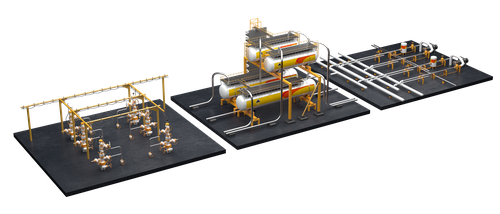
UPSTREAM Modeling
RN-SIMTEP is a software package for modeling technological processes in transportation, treatment and primary processing of well products. It is designed to solve problems at the stage of oil fields design and operation.


RN-SIMTEP is a software package for modeling technological processes in transportation, treatment and primary processing of well products. It is designed to solve problems at the stage of oil fields design and operation.

RN-SIMTEP contains an extended database of components, including reference data and parameters from the commercial software.
PVT-module allows:
Calculation of flowsheets in RN-SIMTEP takes into accont the following effects:
RN-SIMTEP makes it possible to simulate gathering, processing and RPM systems in a single project. This allows implementing an integrated approach to modeling of surface facilities. Joint simulation provides an optimal operating mode and management selection for the whole Gathering/Processing/RPM process chain.
RN-SIMTEP makes it possible to conduct an economic evaluation of the field development project. The module for calculating economic indicators is aimed at assessing the cost of development and construction and determining investment efficiency. It is possible to quickly solve the tasks of a pre-design feasibility study based on the surface facilities already modeled in RN-SIMTEP, compare them, and analyze the sensitivity of investment projects.
It is possible to predict complications (corrosion, ARPD, hydrating, scale) for any surface facility. Based on modeling under various conditions, the optimal management solution is selected to minimize the risks of complications.
RN-SIMTEP has an intuitive and easily customizable interface, it was developed taking into account the requests of specialists involved in modeling technological processes. Models from commercial software can be imported. New functionality monthly.
RN-SIMTEP makes it possible to work with compositional and Black Oil fluid models.
Black Oil model creating includes the following operations:
Compositional model creating includes the following operations:
RN-SIMTEP contains three sections for modeling gathering, processing and RPM systems. Gathering and RPM systems include the subsystems for direct (sequential) calculation and equilibrium calculation (with equilibrium determination at the nodes by the method of contour flow rates). The treatment system section includes various facilities for the treatment of oil, water and gas. Flowsheet creating is the same for all subsystems and includes the following operations:
RN-SIMTEP contains a number of tools for analyzing simulation results:
